If you are like most people, chances are that you don’t use your chainsaw on a daily basis. For the majority of homeowners, this means storing it away until they need to use it again. If you’re looking for some tips and tricks about how to store your chainsaw and keep it in great condition while waiting for its next outing, then read on!
Table of Contents
Why is just storing the chainsaw a bad idea?
Storing a chainsaw in the wrong way can be your first mistake that will lead to further problems. Stored improperly the saw may rust, lose tension on chain or belt, and even cause it to develop electrical problems. All of these are very common problems that can be avoided by following a few simple instructions.
While some people may choose to keep their saws out all year long, this isn’t always safe for the tool itself and often leads to more damage than good if not properly maintained.
How to store a chainsaw for 1-4 months?
It’s important to know that the longer a chainsaw is left unused, the higher chance it will have of developing problems. So if you don’t plan on using your saw for several months during winter or even just one month each year before summer, here are some simple steps to take:
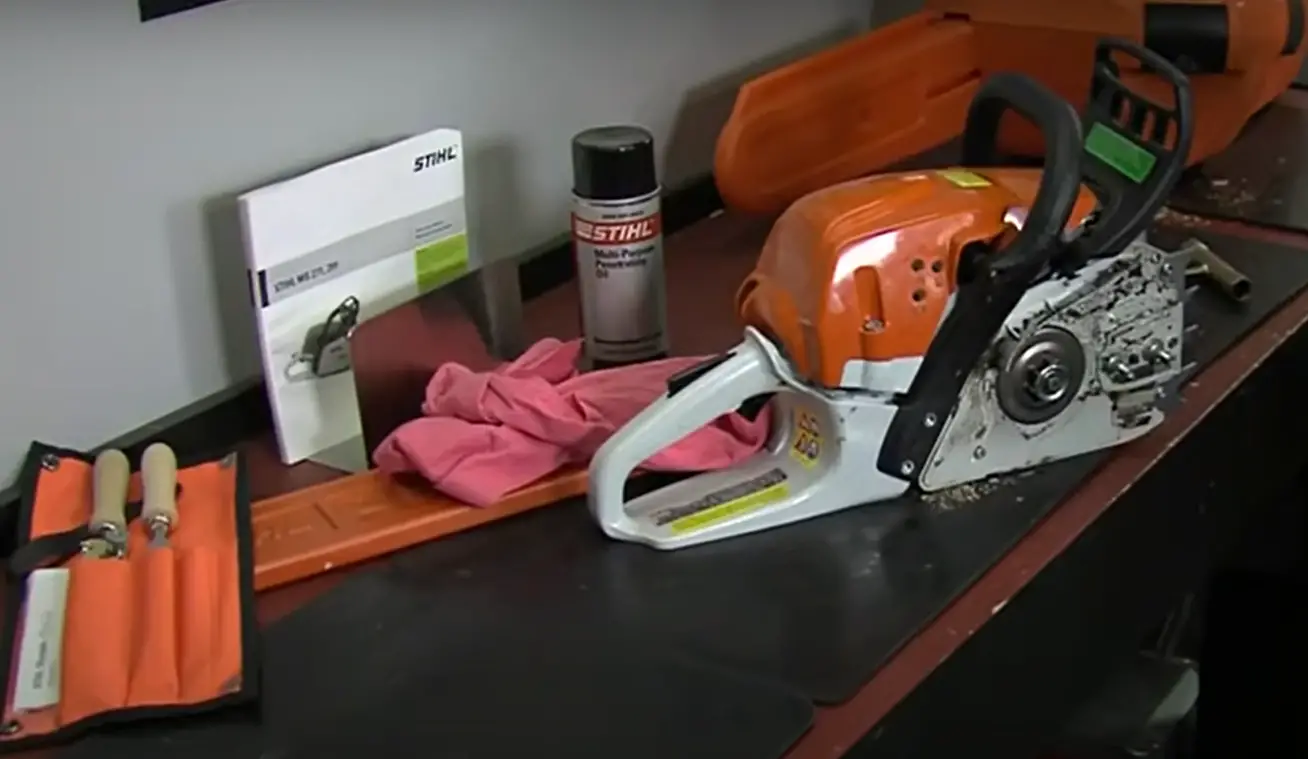
- The first thing everyone should do when storing their tool is drain all fuel from the tank and carburetor by running until the engine dies out completely then removing spark plug wire leaving only the bare metal ends exposed. This helps prevent any fire hazards as well as prevents gumming up which can occur with stale gas in an enclosed area over time;
- Then place a protective bag around the machine taking care not to touch electrical components with your body or clothing. It’s also a good idea to store the chainsaw with its bar and chain removed as well as any tools needed for services such as spare spark plugs or oil filters;
- Finally, place your saw in an area that is cool and dry like a garage where it won’t be exposed to excessive moisture levels which can lead to mold growth on plastic components;
How to store a chainsaw for a long time (1+ years)?
While the most common length of storage is between 1-4 months, some saws will be stored for much longer periods. It’s important to note that these tools should not receive anything but a periodic check-up before use as rust and other problems could begin developing inside if left too long without service or maintenance
If you plan on storing your chainsaw for more than six months it’s best to take out all oil from the engine by running until it runs dry then filling it up with fresh gas which helps prevent rusting during this time period. Remember never store any gasoline in an enclosed area like a garage over winter because vapors can lead to explosions due to cold temperatures!

If placed in a cold area where the temperature is below 32 degrees Fahrenheit, it’s important to place your saw in an unheated garage or shed so moisture doesn’t develop during this time period which can cause rusting and possible electrical problems.
Even if you’re not storing your chainsaw for a few weeks or several months, there is always the possibility that it will be exposed to water which can lead to rusting and other damage unless good precautions are taken when doing so.
It’s best to keep them out of direct sunlight with no exposure whatsoever to rain, snow, or any moist air like inside garages where humidity occurs in high levels over time.
Tips about the storage of a chainsaw:
1) Choose the correct position to store:
- Don’t hang it on a wall, because the chainsaw might fall and hurt someone;
- Store in an area that is easy to access;
- Keep away from children or pets who could accidentally harm themselves if they came into contact with your tools;
2) Use a protective case:
- Using a protective case will ensure your chainsaw is kept in the best possible condition;
- It also saves you from unnecessary damage to your tool. Most cases are sturdy enough to protect them from falls and drops, which can be disastrous if they happen when using a saw;
- Using the case can also help protect you by keeping your chainsaw in one place;
- If you are transporting, storing, or even holding it when not using it, then it’s best to keep it inside a protective case for chainsaws. This will avoid any potential damage that could happen if the saw is knocked over or dropped accidentally. It is very important that users take proper care of their tools and use them properly too;
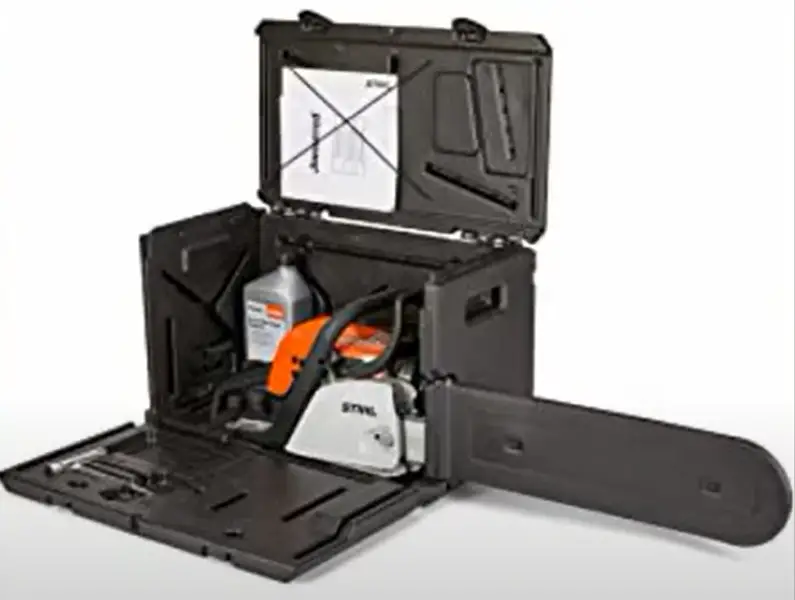
3) Empty the fuel tank:
- Before you store your chainsaw, you should empty the fuel tank to prevent it from corroding and rusting;
- When you store a chainsaw, all that is required of the user to do is wait for an hour or two before draining the fuel tank and then wipe it down lightly with a cloth;
- After this, remove the spark plug from your tool and place both in a bag as well as storing them securely away until next use;
In addition to ensuring there’s no chance of leakage during storage, doing so also ensures your saw doesn’t accidentally startup while being stored which could cause damage if not handled properly because gasoline residue can corrode blades over time even when they’re not used!
4) Dismantle the chainsaw:
- Dismantling a chainsaw before storage is also important because it prevents any possible damage from occurring to your tools;
- The process of dismantling can vary depending on the type and model you have, so check the instruction manual carefully beforehand if necessary;
- You may need an Allen key or screwdriver for this task as well as another person’s assistance for some types/models which require two people to do it safely;
5) Store in a dry and dark place:
- Store your chainsaw in a well-ventilated place to avoid moisture build-up which could affect the quality of the tool;
- If you are storing it outside or somewhere that experiences harsh conditions, then make sure there is no excess water because this can also cause damage over time to plastics and rubber parts as well as corroding metals like aluminum which will result in an overall weaker product after some time;
- It is also important to store them in an area where they are not exposed to extreme temperatures because this will cause the chainsaw’s oil and gasoline inside it to expand or contract which can damage internal components;
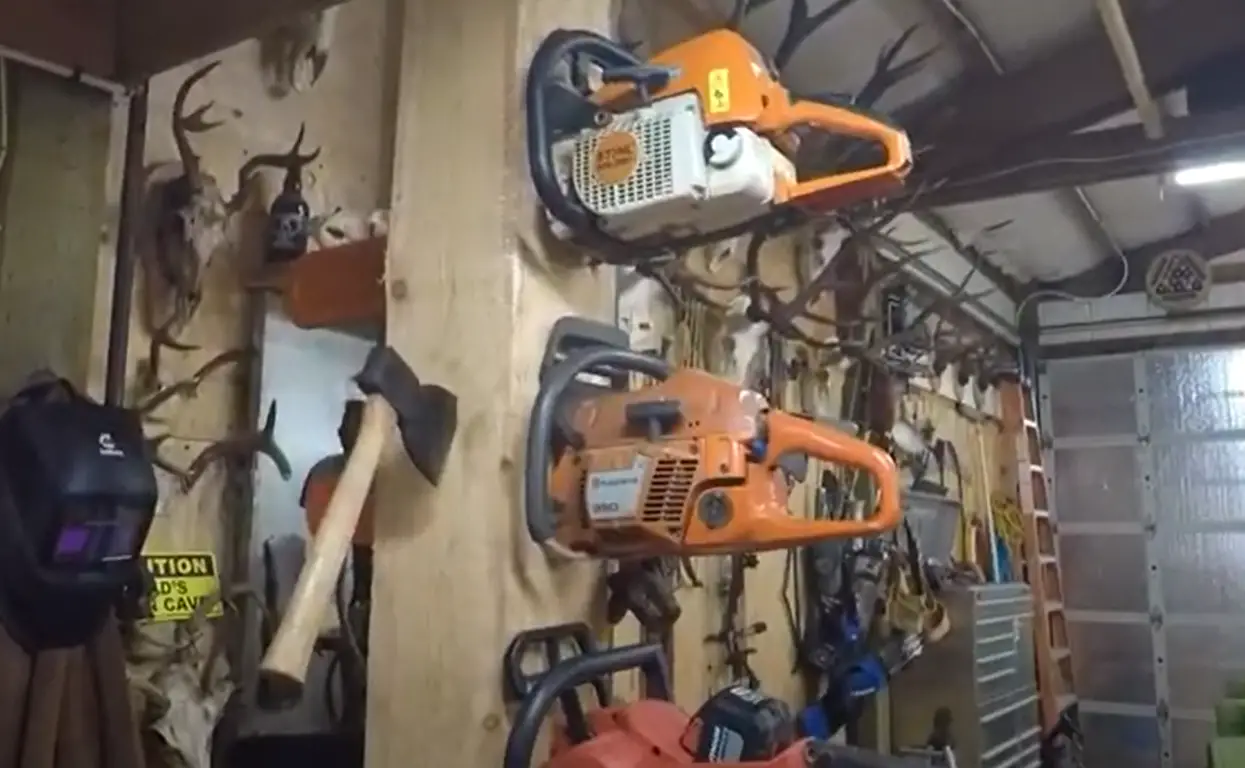
You should try your best to avoid storing tools out in damp, wet conditions as well! This might seem obvious but even if you do store these items indoors, moisture could still be present around the tool due to its surroundings like walls for example that absorb humidity from time to time. Storing a saw away like this could result in rusting over long periods of time especially when there is condensation on metal parts too so make sure any storage environment has suitable air circulation. If possible, keep tools stored somewhere dry with good ventilation.
6) Protect from the sun:
- Try to keep the tool away from areas that are exposed to sunlight for long periods of time because it can damage your chainsaw;
- Exposure to direct sunlight will cause parts like the rubber grips and plastic covers on some models, as well as protective cases, which all deteriorate over time when left out in sunny weather conditions! The sun’s rays also create high temperatures but not suitable storage environments so if you do store them outside, try covering or arranging them somewhere shaded where they won’t be subjected to such harsh climates;
7) Make sure it stays dust-free:
- A chainsaw should be stored in a place with low humidity and away from rain or moisture;
- Since dust is highly abrasive, it can damage your tools so try to keep them clean by wiping down any dirt as soon as possible before storage if you’re going to do this;
- Some people also recommend lightly oiling metal parts that could rust such as the bar and chain even during springtime when there’s still cold air present outside that might affect those components more than usual because of its temperature differences;
Dust is never good for saws, especially on moving parts like sprockets and bars where they may accumulate over time due to lack of use combined with conditions around the tool itself. If areas aren’t cleaned regularly after use, dust and dirt may affect the quality of your saw so try to keep it clean before storing.
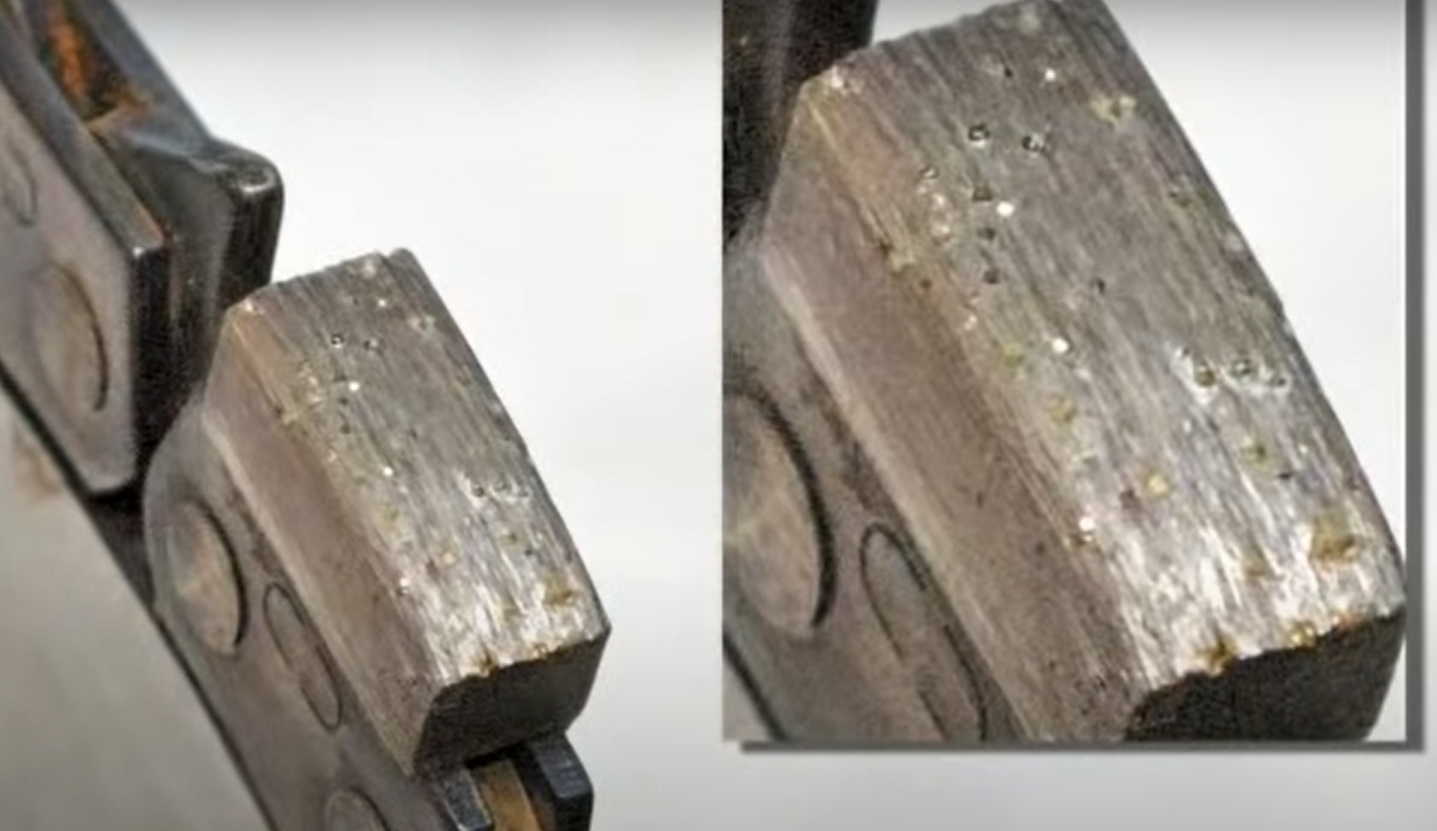
Other things to consider:
- It should be stored off the ground with a solid base of wood or metal underneath it. This will protect both the saw and its owner by preventing serious injuries from falls during storage, which can happen easily if you are not properly maintaining your tool;
- If you do not have room inside your home or shed, another option may be hanging it safely on an exterior wall in a location where there isn’t too much moisture exposure around. You want to make sure whatever surface is used does not contain any water spots as they could cause rusting over time potentially harming how well the machine works when needed next season again;
- Also, make sure you avoid touching moving parts with your hands because this will result in excess oil transferring over which could get on other components after storage that can cause damage if not removed properly;
- Never attempt to touch the chain, sprocket, or tensioner gears with your bare hands. Even one drop of sweat from our skin can cause rusting faster than you know it and lead to an expensive repair bill in the future if not properly maintained during storage periods;
- If possible, store chainsaws inside a toolbox or cabinet for more protection from outside elements like moisture and debris. This also provides better security when transporting them around as well just in case any accidents happen such as dropping the unit accidentally causing high impact damage during transport due to its own weight plus contents within the box itself which are usually heavy tools too;
Comparison of Different Chainsaw Storage Options
Proper chainsaw storage is crucial to ensure its longevity and safe usage. There are different storage options available, such as hanging, storing in a case, or using a rack. This table provides a comparison of various storage options based on their cost, convenience, and safety.
| Storage Option | Cost | Convenience | Safety |
|---|---|---|---|
| Hanging | Low | High | Low |
| Case | Medium | Medium | High |
| Rack | High | Low | High |
The table compares three different chainsaw storage options: hanging, storing in a case, and using a rack. The cost of each option is evaluated as low, medium, or high. The convenience of each option is also evaluated as high, medium, or low. Finally, the safety of each option is evaluated as high, medium, or low.
Based on the comparison, hanging the chainsaw is the least expensive option but also the least safe, while storing it in a case is a medium-cost and medium-convenience option with high safety. Using a rack is the most expensive option but also the safest, although it may not be the most convenient option.
Overall, choosing the best storage option depends on personal preferences and circumstances, but considering the cost, convenience, and safety factors can help make an informed decision.
FAQ
What is the proper way to store a chainsaw?
The proper way to store a chainsaw is with an automatic oiler, clean and dry chainsaw after each use. Check the tension periodically on your chain so you can keep it properly adjusted without any trouble when needed next season again in case there are any issues that could affect its performance if left for too long in storage conditions.
How do you store a chainsaw when not in use?
Store your saw off the ground with a solid base underneath like wood or metal depending on where you’re going to put it away safely at homes such as inside a shed or garage. This will protect both the tool itself and whoever uses it by preventing serious injuries from falls during storage that can happen easily if not maintained properly before storing them over time!
Make sure whatever surface is used does not contain water spots either because they can cause rusting fast which would be expensive to repair.
Can chainsaws be stored vertically?
When you hang your chainsaws vertically, there’s a possibility that the bar and chain oil and gasoline will leak out of the saw and run down the bar.
If you’re not careful, gasoline and bar and chain oil will leak from the saw. As a result, if this happens, there’s no way to stop it. So, what can you do? You may either drain the fuel and bar and chain oil from the saw or remove any possible sources of ignition.
Hang it and then return in a few days to “burp” the liquid and oil tanks. The pressure in these containers builds up over time, causing the liquid to leak out.
By burping the tank, you will eliminate this pressure and prevent the liquid from leaking out. All you have to do to accomplish this is twist open the tanks wide enough to allow the gases to escape.
Because you may empty the fluids before putting them away, experts suggest utilizing this method for longer-term storage [1].
Is it good to store a chainsaw on its side?
According to some users, you should store a gas-based chainsaw only upright. If you keep it on the side, it may leak gas or fuel (especially if it is full) [2].
Can you hang a chainsaw for storage?
Hanging chainsaws is a fantastic method to save space in your garage or storage area. You can keep them hanging in a few different ways, such as by the hooks:
1) Hang by rear handle
This is a simple method to hang your chainsaws. Use a wall hook or something similar and hang your saw from the rear handle, which has the trigger attached.
If you hang your chainsaw in this manner, the gasoline and oil may run down your chainsaw bar, but it’s also possible that they’ll leak onto the blade.
If this doesn’t work, drain away any fluids before storage or burp the tanks after they’ve been hanging for a few days.
To burp the fuel tank, open it and the bar and chain oil tank to release the trapped air.
The tanks will not link together while they are trapped in this manner.
2) Hang by the brake stop
The handle that’s along the top of the saw and hangs from the brake stop won’t leak fluids as readily as the rear handle.
However, the brake handles on chainsaws aren’t particularly durable. As a result, experts recommend only utilizing this for small saws. If the weight is placed on the brake stop too heavily, it may break or be damaged.
Saws with longer bars will be unbalanced and will therefore not be able to hang by the brake stop and maintain a relatively level position, they’ll tilt forward.
If you have a number of chain saws to store in a limited area, consider hanging the smaller ones on the wall and storing your bigger chainsaws on the ground or on a shelf.
How to store a chainsaw between seasons (winterize it):
- Allow the engine to cool;
- Remove any debris from the lines and connectors, then drain the gas tank, gas lines, carburetor, and line connections of any remaining fuel;
- To prevent fuel from accumulating gum deposits, add a fuel stabilizing agent to the gas tank; run the saw for 3 minutes after adding to distribute the stabilizer throughout the engine;
- Remove the chain and bar from the engine’s drive assembly;
- Remove all dirt, wood chips, and grime from the drive gear, chain bar, and chain connection area;
- Clean out debris, oil, grease, grime, and wood chips from the chain drive gear and bar connection region. It’s time to sharpen the chain or replace it now;
- After reassembling the chain bar and chain, fine-tune the tension so that when you pull on it slightly, it snaps into place;
- Wipe it down with a cloth or paper. To prevent rust, lightly oil the outer metal surface and the guide portion;
- Remove the air breather and clean it as directed in your owner’s handbook. Most breathers can be cleaned with soap and then blown dry with compressed air;
- Remove the spark plug and fill the gap with 1 teaspoon of 2-cycle engine oil;
- Pull the starter rope 8 to 10 times to distribute the oil before replacing the spark plug [3];
- Remove the old air filter and clean it. Any loose screws, nuts, and bolts should be tightened;
If the old spark plug appears to be dirty or sticky, it might indicate incomplete combustion of the fuel, which might be caused by a faulty fuel/oil combination or spark plug gap setting.
Keep the chainsaw in a clean, dry, dust-free storage case out of the reach of children.
How to empty the tank and run dry before storage?
All of the fuels in the chainsaw’s fuel tank should be emptied. When the tank is completely empty, yet there is still non-drainable oil left, you must set it in a lower position and run the chainsaw. Don’t use it to chop wood; simply run it to turn off when the fuel runs out [4].
How to apply oil to a chainsaw?
You should oil your chainsaw at least once per season. However, you want to apply more if it’s seen considerable use:
- Place the bar tip near or on top of a log and make sure that there is no debris in between them;
- Start the saw with reduced speed so as not to drive wood chips into the guide bar and sprocket area;
- The teeth will cut down through the bark deep enough for sapwood but they won’t go deeper than necessary into older heartwood;
- If you consistently start this process by applying machine oil to both sides of each tooth using either paintbrush or an old sock, eventually all links in your chain will be lubricated evenly without having used extra lubricant repeatedly;
How to store a pole saw?
A pole saw is a great tool for pruning trees and shrubs, but it can be difficult to store. To ensure your pole saw remains in good condition, there are a few things you should consider when storing it.
First, make sure the pole saw is clean and dry before storage. This will help prevent rust or other damage from occurring while in storage. Additionally, if possible, store the pole saw in a cool and dry place such as a shed or garage. If you don’t have access to these types of spaces, try wrapping the pole saw in plastic or covering it with a tarp to protect it from the elements.
Finally, if possible, hang your pole saw on a wall or use a storage rack that will keep it off the ground and organized. This will help prevent accidental damage to the blade and handle by keeping it out of harm’s way.
How to store a manual pole saw?
Storing a manual pole saw properly is essential for its longevity and safety.
The first thing to consider when storing a manual pole saw is where you will keep it. It should be stored in a dry, cool place away from direct sunlight and other sources of heat. If possible, hang the pole saw on the wall or use a specially designed storage rack. This will help prevent the pole saw from becoming damaged due to moisture or other environmental factors.
It’s also important to make sure that the pole saw is clean before storing it away. After each use, make sure that you wipe down the blade and handle with a damp cloth to remove any dirt or debris. Once the pole saw is clean, apply a light coat of oil to protect against rust and corrosion. Finally, make sure that all parts are securely fastened before putting away your manual pole saw.
How to store a gas pole saw?
Storing a gas pole saw correctly is important for both safety and maintenance purposes. To store a gas pole saw, start by draining the fuel from the tank. This will prevent any potential damage to the engine or fuel system due to old fuel sitting in the tank. Next, carefully clean the saw with a cloth and some soapy water, paying special attention to any oil or grease on the blade and engine. Finally, store the saw in a dry area that is away from extreme temperatures or moisture. Make sure to cover it with a protective tarp or plastic sheeting if needed. With proper storage, your gas pole saw should remain in good condition for many years.
How to store an electric pole saw?
Storing an electric pole saw is easy and straightforward. First, make sure the pole saw is unplugged from any power source. Then, use a clean rag to wipe down the blade and handle of the saw to remove any dirt or debris. Once it is clean, you can store the pole saw in a dry place such as a garage or shed.
If you have limited space, you can also hang your pole saw on a wall or ceiling with an appropriate mounting bracket. Be sure to secure it firmly so that it does not come loose during storage. Additionally, if you are storing your pole saw for an extended period of time, consider using a cover to protect the blade and handle from dust and moisture.
Finally, be sure to check all of your connections before plugging in your pole saw to ensure that everything is still working properly before use. With these simple steps, you can easily store your electric pole saw safely and securely.
Useful Video: Chainsaw Storage (2 Important things you must do first)
References:
1. https://burlybeaver.com/chainsaw-storage-faqs
2. https://www.arboristsite.com/threads/storing-your-chainsaw-lay-it-on-the-side-or-the-bottom.239500
3. https://www.searspartsdirect.com/diy/article/how-to-store-a-chainsaw-between-seasons
4. https://www.powertoolhunter.com/how-to-store-a-chainsaw/

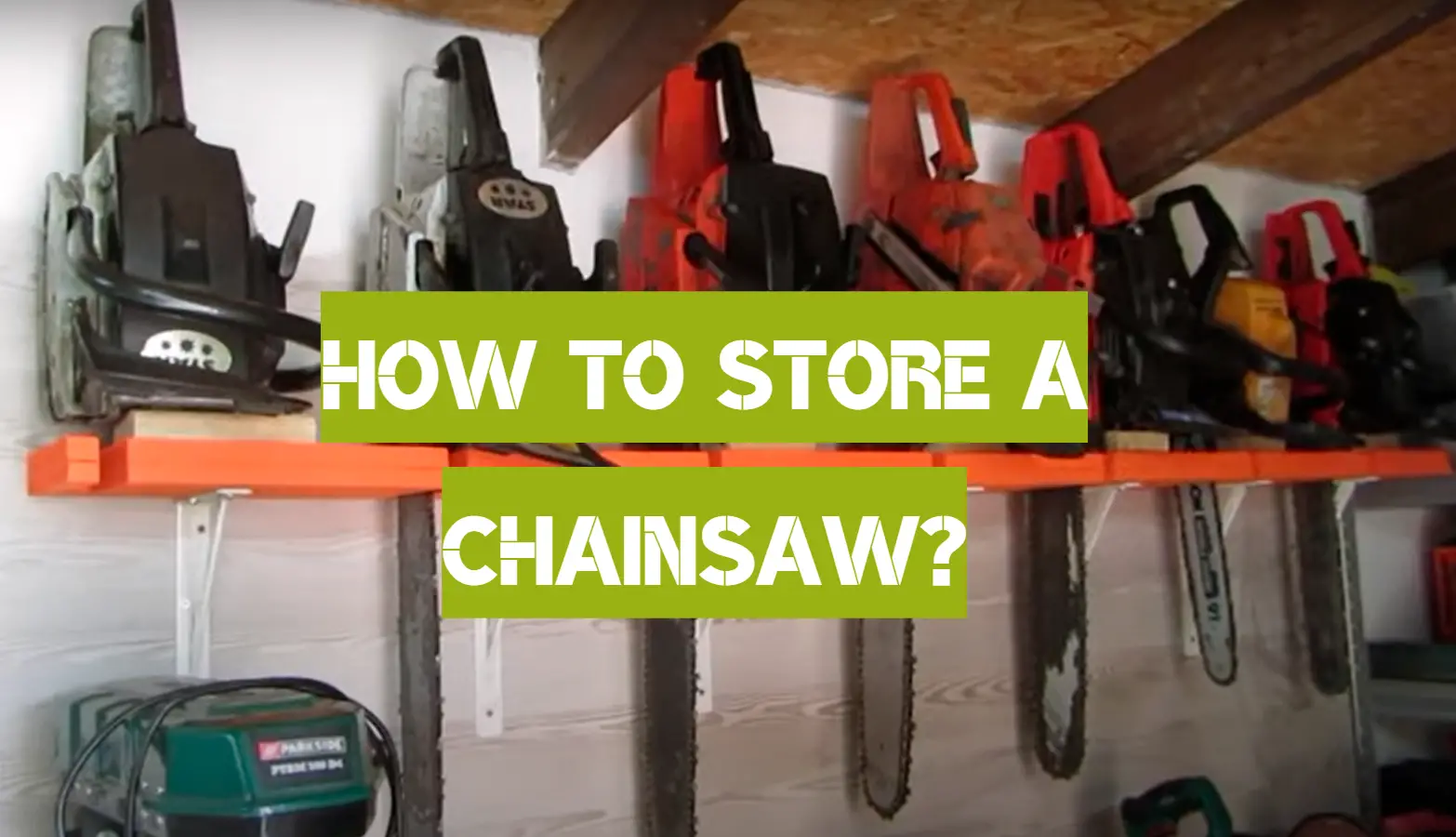





Leave a Reply